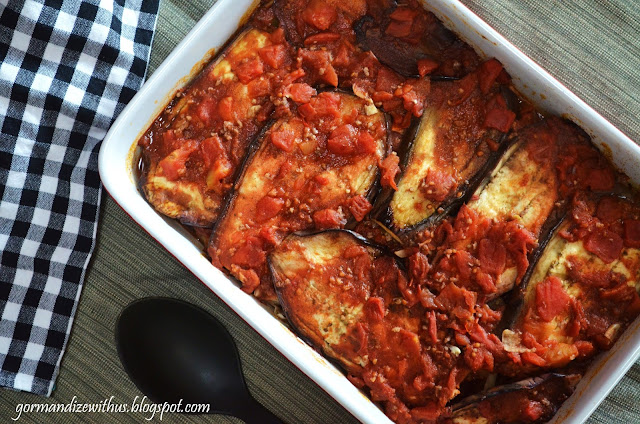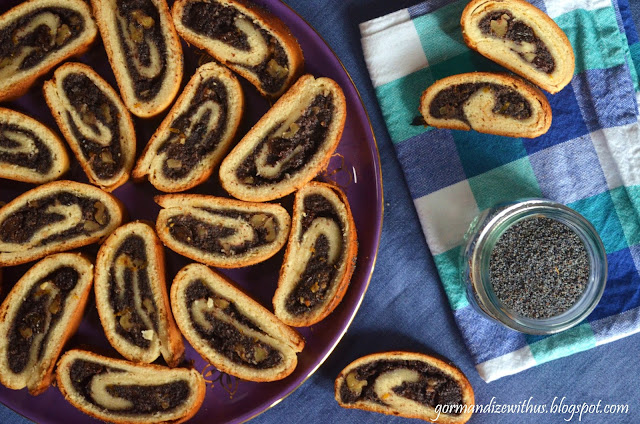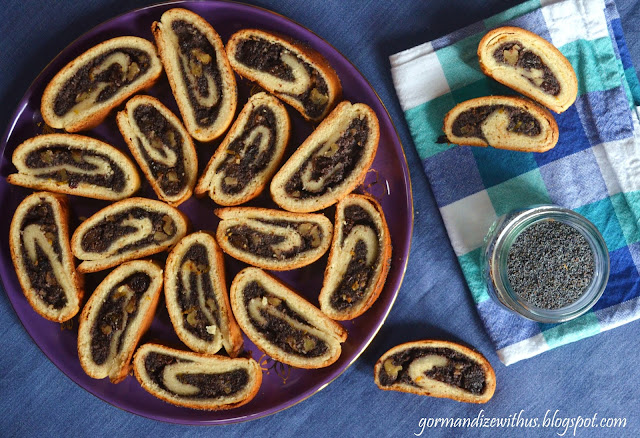September has been a very busy and very delicious month for me! Not only was I posting up lots of Egyptian recipes, but I signed myself up for VeganMofo - which was a lot of work!! I didn't even get to post everything I had planned for VeganMofo and yet I still feel like I posted a mammoth amount of posts. Looking forward to next year's VeganMofo already though, as it was pretty fun. Also, I've got so many spices left on my spice rack to experiment with.
Egypt Month was a great one to pair with the My Spice Rack theme, because it uses up lots of delicious spices! Look how colourful it all is in the photos, doesn't it look gorgeous?
Ingredients of the Month: Cumin, All Spice, Citrus
~Savoury~
 |
| Mesa'a'ah - Spicy Egyptian Eggplant |
I'm a real sucker for baked eggplant dishes. Well, eggplant in any form really. So I couldn't pass by this tasty dish. It's called Mesa'a'ah (or Mesa'a'a or even sometimes just Mesa'a) - Eggplant and onions layered in a baking dish and smothered with spicy tomato sauce. It's quite hot with the inclusion of green chilli, but you can make a milder version to suit any palate. Check out the recipe here.
 |
| Orange & Olive Salad with Cumin |
Not too sure on the authenticity of this one - but don't let that stop you because it was one of my favourite dishes of the month (ok, that is a tough call...), it's light and refreshing nature makes it pair perfectly with the spicy dishes we ate (such as the Mesa'a'ah, above). I'd never had a salad quite like this before and I will definitely be making it again! Check out the recipe here.
 |
| "Ancient Egyptian Peasant" Beer Onions |
Ok (admission!), this one comes with a bit of creative license. I don't think anyone in Egypt ever cooks this dish! BUT, it was inspired by my research into Egyptian food. While I was reading up on Egyptian food and history I came across a fun fact - peasants and labourers in ancient Egypt were often paid with onions and beer. Now, I'm not suggesting they whipped them up together in a dish like this - but it made my mind tick and I thought that they would work great together. They did - it's delicious. Perfect for a side dish or as a filling in a pie or atop some tart shells as an appetiser, or on a foccacia even. There are so many things you could do with these onions! So don't let pesky authenticity stop you! Just eat these onions and be glad you're not an Egyptian peasant. Check out the recipe here.
 |
| Egyptian Tahini Sauce |
This is sometimes translated as a Tahini Salad by Egyptians on the internet, which is interesting because it's not what we would think of as a salad in many countries. Whatever you want to call it though - this dish is very versatile. You can use it as a salad dressing, as a sauce, as a dip or just to eat on the side of anything. It's perfect drizzled over your felafel or your salad stuffed pita bread. Check out the recipe here.
 |
| Ful Medames |
Ful Medames is a ubiquitous dish in Egypt, and it's actually often eaten for breakfast. I think it's suitable for any time of day though! There are many different ways to make Ful Medames, every family has a slightly different recipe. This one was perfect eaten on pita bread and with a dollop of tahini sauce to accompany it. Check out the recipe here.
~Sweet~
 |
| Khushaf |
 |
| Limonnada |
This Egyptian lemonade it something quite special. It's mostly just lemon juice and only a little bit of sugar- which means it's very strong and is designed to be drunk just a little bit in your glass and topped up with soda water (or lemonade if you want it sweeter). The beautiful touch of orange blossom water to flavour it gives it a special and unique flavour. Plus the fact that you only drink a bit at a time topped up with soda water meant that this small jug of it happily kept 10 people happy all night! Check out the recipe here.
~Condiments~
 |
| Preserved Lemons |
I hope you've enjoyed this month of Egyptian food! I ate sooo much :) Which dishes do you think look the best?
After all that posting for Egyptian food month and VeganMofo, I think I might need a bit of a rest for my sanity. But next month I'll be back into the world of food (after a week off I think!).
Next month we'll be having lots of dishes from.....
Nepal!
Very exciting to get stuck into Nepalese (or is it Nepali?) cuisine, keep your eyes out for the recipes.















1.jpg)




























